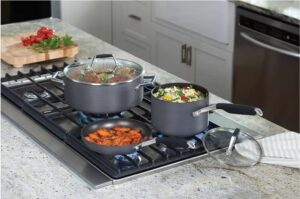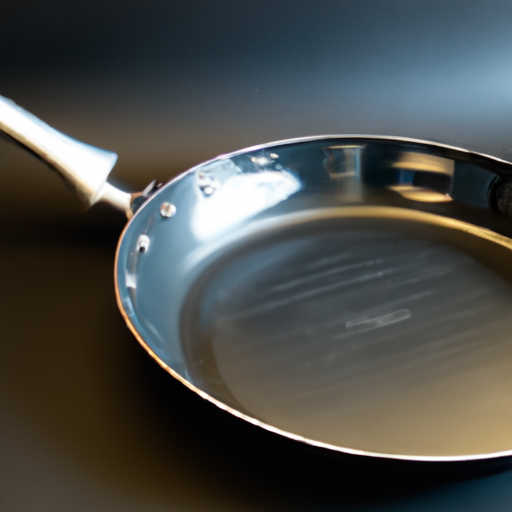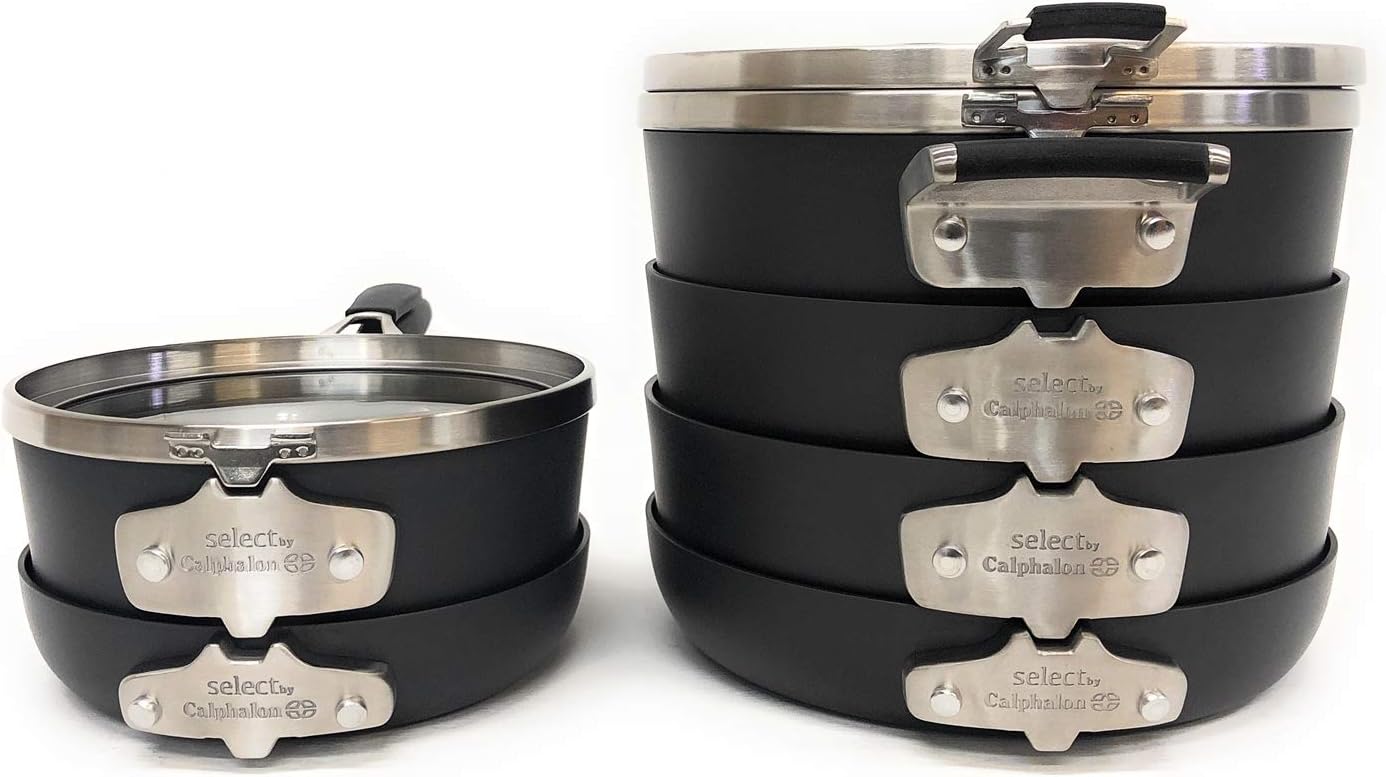If you’re a proud owner of Calphalon cookware or considering purchasing some, it’s important to know how to properly care for your pots and pans. From cleaning to preventing sticking, this article will provide you with all the information you need to keep your Calphalon cookware in top condition. Whether you have non-stick, stainless steel, or cast iron Calphalon cookware, we’ll cover everything from how to season your pans to how to remove stains. With these tips and tricks, you can ensure that your Calphalon cookware will last for years to come.
This image is property of images.pexels.com.
What is Calphalon cookware?
Overview of Calphalon cookware
Calphalon cookware is a popular brand of cookware known for its high-quality and durability. It offers a wide range of pots, pans, and other cooking utensils that are designed to meet the needs of both professional chefs and home cooks. Calphalon cookware is made from various materials, including stainless steel, hard-anodized aluminum, and non-stick coatings. With its excellent heat conductivity and even heat distribution, Calphalon cookware ensures that your food is cooked evenly and to perfection. Whether you’re frying, sautéing, or simmering, Calphalon cookware is a reliable choice for all your cooking needs.
Is Calphalon cookware safe to use?
Safety considerations of Calphalon cookware
Yes, Calphalon cookware is safe to use. It is made from high-quality materials that are designed to withstand high temperatures and resist scratches, stains, and other damaging factors. However, it is important to follow the manufacturer’s instructions for use and care to ensure the longevity and safety of your Calphalon cookware. For example, avoid using metal utensils with non-stick Calphalon pans to prevent scratching the surface and compromising the non-stick properties. Additionally, it is important to clean and maintain your Calphalon cookware properly to prevent the buildup of harmful bacteria or other contaminants.
Upgrade your kitchen with the Calphalon Cookware 8-Piece Pots and Pans Set. Durable, nonstick, and oven-safe, this cookware is perfect for all your culinary from other brands?
Unique features of Calphalon cookware
Calphalon cookware stands out from other brands due to its unique features and innovative designs. One of the key features of Calphalon cookware is its use of different materials for specific cooking needs. For example, Calphalon stainless steel cookware offers excellent heat conductivity and durability, making it ideal for searing and browning. On the other hand, Calphalon non-stick cookware is perfect for low-fat cooking and easy food release. Additionally, Calphalon cookware is known for its ergonomic handles, which provide a comfortable grip and stay cool during stovetop use. The high-quality construction and attention to detail set Calphalon cookware apart from other brands.
What materials are Calphalon pots and pans made from?
Materials used in Calphalon cookware
Calphalon pots and pans are made from various materials, each with its own unique properties and benefits. Some of the most commonly used materials in Calphalon cookware include:
- Stainless Steel: Calphalon stainless steel cookware is durable, non-reactive, and resistant to rust and corrosion. It offers excellent heat conductivity and is suitable for a wide range of cooking techniques, including searing, sautéing, and simmering.
- Hard-Anodized Aluminum: Calphalon hard-anodized cookware is known for its exceptional heat distribution and durability. It features a non-porous surface that resists scratches, stains, and corrosion. Hard-anodized aluminum cookware is also lightweight, making it easy to handle and maneuver.
- Non-Stick Coating: Calphalon non-stick cookware is coated with a durable non-stick surface, which allows for easy food release and hassle-free cleanup. The non-stick coating is made from PTFE or ceramic materials, depending on the specific product line.
Each material used in Calphalon cookware has its own benefits and features, allowing you to choose the best option for your cooking needs.

This image is property of images.pexels.com.
Is Calphalon non-stick?
Explanation of non-stick properties in Calphalon cookware
Yes, Calphalon offers a range of non-stick cookware that is designed to prevent food from sticking to the surface. Non-stick cookware is coated with a special material that allows for easy food release and effortless cleaning. Calphalon uses two types of non-stick coatings: PTFE-based and ceramic-based.
PTFE-based non-stick coatings, such as Calphalon’s Classic and Contemporary non-stick cookware, are made from a material called polytetrafluoroethylene. PTFE is known for its excellent non-stick properties and durability. It provides a smooth, non-porous surface that prevents food from sticking and makes cleanup a breeze.
Ceramic-based non-stick coatings, such as Calphalon’s Premier and Signature non-stick cookware, are made from a ceramic material that is free from PTFE and PFOA. Ceramic non-stick coatings offer similar non-stick performance to PTFE-based coatings, but with the added benefit of being more environmentally friendly.
No matter which type of non-stick cookware you choose from Calphalon, you can expect it to provide excellent food release and easy cleanup.
How do I clean Calphalon
cookware non-stick?
Step-by-step guide to cleaning non-stick Calphalon cookware
Cleaning Calphalon non-stick cookware is a simple and straightforward process. The following step-by-step guide will help you keep your non-stick pans looking and performing their best:
- Allow the cookware to cool down completely before cleaning.
- Fill the sink with warm water and add a small amount of mild dish soap.
- Use a soft sponge or dishcloth to gently scrub the surface of the cookware. Avoid using abrasive scrub brushes or metal scouring pads, as they can scratch and damage the non-stick coating.
- For stubborn, stuck-on food residue, fill the pan with warm water and a few drops of dish soap. Let it soak for 15-30 minutes, and then gently scrub the surface with a sponge or dishcloth.
- Rinse the cookware thoroughly with warm water to remove any remaining soap residue.
- Dry the cookware with a soft towel or allow it to air dry completely before storing.
It is important to note that Calphalon recommends avoiding the use of harsh or abrasive cleaners, as they can damage the non-stick coating. Additionally, it is best to avoid using metal utensils with non-stick Calphalon pans, as they can scratch the surface and compromise the non-stick properties.

Can I use metal utensils with
non-stickCalphalon cookware?
Guidelines for using utensils with Calphalon non-stick surfaces
Calphalon recommends using plastic or wooden utensils with their non-stick cookware to prevent scratching and damaging the non-stick surface. Metal utensils, such as spoons, spatulas, or whisks, can easily scratch the non-stick coating, compromising its non-stick properties.
To ensure the longevity and performance of your Calphalon non-stick cookware, it is best to follow these guidelines:
- Use plastic, silicone, or wooden utensils when cooking with non-stick Calphalon pans.
- Avoid using metal utensils, as they can scratch the non-stick surface and reduce its non-stick properties.
- If you accidentally use a metal utensil on your non-stick pan and notice any scratches or damage to the coating, it is best to stop using the pan and replace it if necessary.
By following these guidelines, you can prolong the life of your Calphalon non-stick cookware and ensure optimal cooking performance.
Are Calphalon pans oven-safe?
Temperature restrictions for using Calphalon pans in the oven
Yes, most Calphalon pans are oven-safe. However, it is important to note that the specific temperature restrictions may vary depending on the material and product line. To determine if your Calphalon pan is oven-safe, check the manufacturer’s guidelines or the packaging of your specific cookware.
Generally, Calphalon stainless steel and hard-anodized aluminum pans are safe to use in the oven at temperatures up to 500°F (260°C). However, it is recommended to double-check the temperature restrictions for your specific pan.
It is important to note that the lids of Calphalon pans may have different oven-safe temperature limits. Some lids may have heat-resistant handles or knobs that can withstand higher temperatures, while others may not be suitable for oven use. Always refer to the manufacturer’s guidelines to determine if the lid is safe for oven use.

What is the recommended oven temperature for Calphalon cookware?
Safe temperature guidelines for using Calphalon cookware in the oven
The recommended oven temperature for Calphalon cookware may vary depending on the specific material and product line. However, as a general guideline, Calphalon stainless steel and hard-anodized aluminum cookware can typically withstand oven temperatures up to 500°F (260°C).
It is important to note that this temperature limit may not apply to the lids of Calphalon pans. Some lids may have heat-resistant handles or knobs that can withstand higher temperatures, while others may not be suitable for use in the oven. Always refer to the manufacturer’s guidelines or the packaging of your specific cookware to determine the recommended oven temperature for both the pan and its lid.
By following the manufacturer’s guidelines, you can ensure the safe and proper use of your Calphalon cookware in the oven.
Can I use Calphalon cookware on a smooth-top electric range?
Compatibility of Calphalon cookware with smooth-top electric ranges
Yes, Calphalon cookware is generally compatible with smooth-top electric ranges. Smooth-top ranges, also known as ceramic cooktops, feature a smooth and flat glass surface that provides even heat distribution. Calphalon cookware with a flat and smooth bottom, such as stainless steel and hard-anodized aluminum pans, can be safely used on smooth-top electric ranges.
It is important to note that some Calphalon cookware, particularly non-stick pans, may have specific recommendations or restrictions for use on smooth-top electric ranges. Consult the manufacturer’s guidelines or the packaging of your specific cookware to ensure compatibility and prevent any potential damage to your cookware or the cooktop.
When using Calphalon cookware on a smooth-top electric range, take the following precautions:
- Ensure that the bottom of the cookware is clean and dry before placing it on the cooktop.
- Do not slide or drag the cookware on the cooktop, as this can cause scratches or damage to the surface.
- Avoid using high heat settings unless necessary, as excessive heat can damage the non-stick coating or affect the performance of the cookware.
By following these guidelines, you can safely use Calphalon cookware on your smooth-top electric range and enjoy the benefits of its high-quality construction and cooking performance.


